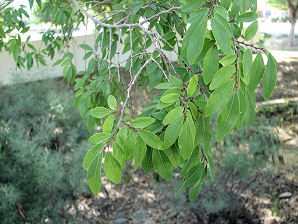Common Landscape Plants. Shrubs, Flowers, & Trees.
For The Arizona Desert Environment
Pictures, Photos, Images,
Descriptions, & Reviews.
Chinese Elm Tree, Ulmus parvifolia.
We Are Proud Of Our SafeSurf Rating!
Click On Any Of The Following Links By Amazon.Com
To View Tools For Desert or Arizona Gardening. No Obligation!
 |
| Chinese Elm Tree, Ulmus parvifolia. |
|---|
 |  |
| Chinese Elm, Ulmus parvifolia. | Chinese Elm, Ulmus parvifolia. |
|---|
 /
/

Chinese Elm Tree.
We wish to thank Wikipedia, the free encyclopedia for some of the information on this page. We share images and information with Wikipedia. The Chinese Elm is a native of China, Korea and Japan. It was introduced into the United States. It has proven to be highly resistant to both the Dutch elm disease and the elm leaf beetle, both of which have been highly destructive to the native American Elm. The distinctive bark of the Chinese Elm is smooth, mottled brown, and sheds in thin flakes, exposing orange to reddish brown inner bark. Landscapers and gardeners have planted it successfully across the southern United States, especially in the Pacific and Gulf regions. It survives well in climatic extremes. Cultivators of trees plant it as an ornamental shade tree on lawns, along streets and in parks
Quick Notes:
Height: Usually 30 - 60 feet, with equal or slightly less spread.
Flowers: Monoecious; inconspicuous, light green in small tight clusters.
Flowering Time: February - April.
Leaves: Alternate, simple, elliptical to broadly lanceolate, to 2 1/2 inches long, pinnately veined, serrate margin; base of leaf is inequilateral, shiny dark green above and nearly glabrous, pale below.
Trunk: Normally up to 8 - 18 inches in diameter.
Soil pH requirements:
Sun Exposure:
Elevation: Can be found growing from 0 - 2,952 Feet.
Habitat: Used as a very common landscape plant in Phoenix. Found wild in riparian canyons and large washes with a perennial source of water. Maintenance: High leaf drop. Not pool friendly. Photos Taken June 06, 2006 Glendale, Arizona.
Miscellaneous: Photos Taken; June 6, 2006. In Glendale, Arizona. it is considered a xeriscape plant. It must have some water.
|
We Are Proud Of Our SafeSurf Rating!
Click On Any Of The Following Links By Amazon.Com
To View Tools For Desert or Arizona Gardening. No Obligation!
| © 1966 - Present, Audrey, Eve, & George DeLange |






